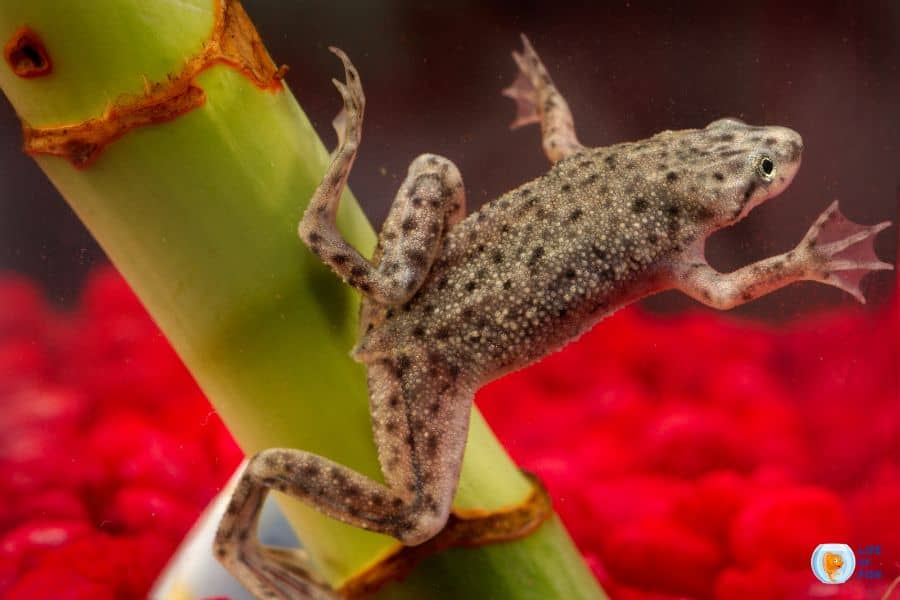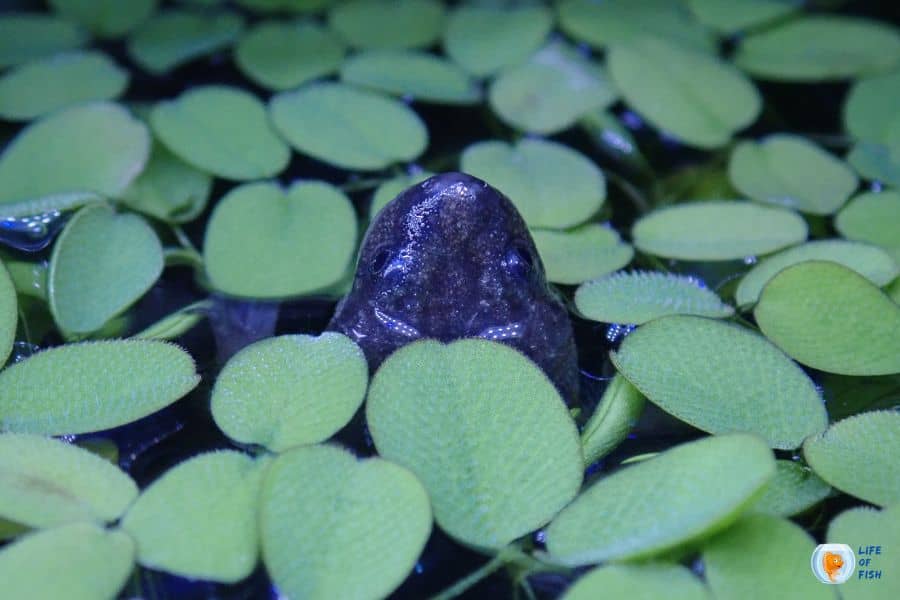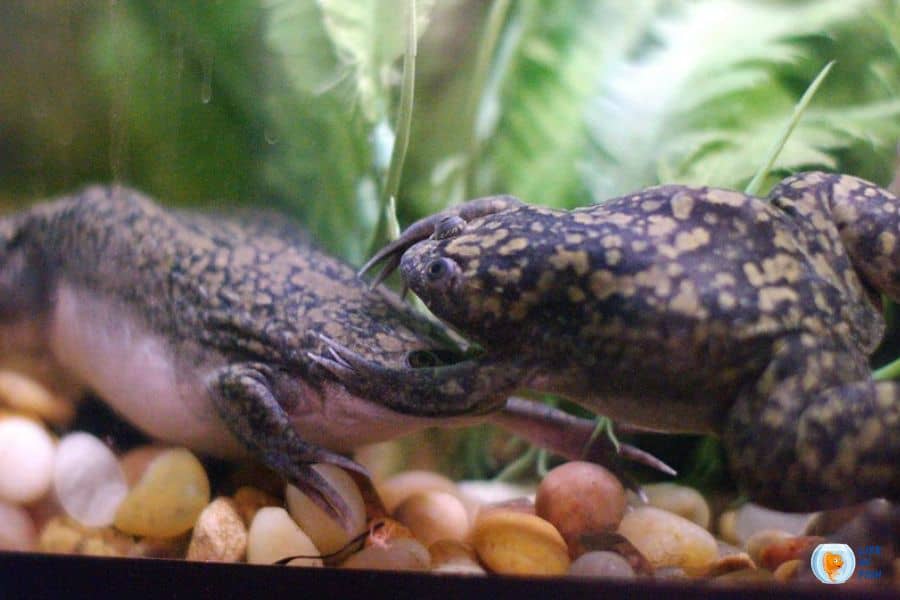I once had an African dwarf frog and kept him in a freshwater tank. But I often ask myself Can African dwarf frogs tolerate aquarium salt? Some of my fellow aquarium friends told me it may be. But I wanted the truth. So I did some research to find out the real story.
Although many freshwater frogs cannot tolerate aquarium salt, these little creatures can tolerate aquarium salt. Many African dwarf frog owners add salt to their tanks in an effort to control algae growth or prevent disease. Actually, aquarium salt can be beneficial for these frogs because it prevents diseases.

However, too much salt can actually cause more problems than it solves. High levels of salt can stress the frogs and even lead to death. As a result, it is important to use salt carefully and only in moderation when keeping African dwarf frogs
What is an African dwarf frog?
Jump To
- 1 What is an African dwarf frog?
- 2 What is aquarium salt?
- 3 How to use aquarium salt
- 4 The potential risks of using too much aquarium salt
- 5 Can I use aquarium salt to treat my African dwarf frog’s skin infections?
- 6 Can I use aquarium salt to control algae growth in my African dwarf frog tank?
- 7 Can I use aquarium salt to prevent disease in my African dwarf frogs?
- 8 Can I use other types of salt in my African dwarf frog tank?
- 9 Conclusion on Can African dwarf frogs tolerate aquarium salt
The African dwarf frog is a freshwater frog species. They originated from the rivers and streams of central Africa. These fully aquatic amphibians live their entire life in the water. African Dwarf Frogs are a popular choice for aquariums because of their small size and peaceful nature.
What is aquarium salt?
Aquarium salt is a popular product among fish owners because it is safe for most species and it helps to keep the water clean. It is a type of salt that is specifically designed for use in freshwater aquariums. Aquarium salt is sodium chloride, which is also known as rock salt. It may or may not contain minerals. It is very beneficial for fish and other aquatic creatures. The main purpose of using aquarium salt is to keep the water clean and clear. Aquarium salt also provides a source of essential nutrients for fish.
The majority of freshwater fish live in habitats with no measurable salinity in their natural environments. Therefore, the use of aquarium salt in a freshwater tank is a widely debated topic amongst hobbyists. Some people recommend doing it all the time to provide fish with essential electrolytes, while others say it’s mostly used for treating diseases. After years of testing with hundreds of fish, many scientists witnessed there is a wide range of advantages to using salt when keeping certain fish species or for treating some illnesses.
Some advantages are listed below.
- Helps relieve stress.
- Treats certain diseases such as ich and brown blood disease (nitrite poisoning).
- Can improve results when used in combination with other treatments or with baths/dips.
- Reduces the uptake of nitrite.
- Promotes the formation of slime coats.
However, you must have good knowledge about the aquarium inhabitants before adding salt, as there are some species of fish plants and frogs that cannot tolerate any salt. The salt amount to use can vary depending on the size and type of fish in the aquarium. Be careful when measuring the salt to be used for your aquarium as it’s easy to overdose the amount, and unlike most medications, salt does not breakdown over time

How to use aquarium salt
Though. Some aquarists use it on a regular basis, it is recommended to use it as a mediation. The method of treatment starts with the lowest level of salt and gradually increases if the symptoms persist.
Level 1 Treatment
| 1 Tbsp Salt per 3 Gallons of Water |
Add 1 tablespoon (Tbsp) of salt per 3 gallons of water. You can either pour the salt directly into the aquarium or dissolve the salt in a small cup of water first and add it to the aquarium. This level of salt is used to treat it like using Neosporin topical ointment for a small cut.
You can use this level of salt concentration to get rid of mild cases of bacterial and fungal infection. It gently irritates the fish’s slime coat too. This is more beneficial as it helps fish to build the mucus that can block some parasites and microorganisms from reaching their body.
You have to keep the affected fish in this solution for 4 to 5 days, and then increase the concentration if there’s no improvement. Although this level of salt is safe for virtually many fish species, you cannot use even this salt concentration for anchor catfish as they cannot tolerate it.
Level 2 Treatment
| 1 Tbsp Salt per 2 Gallons of Water |
Use a concentration of 1 Tbsp of salt per 2 gallons of water for the next level of treatment. Level 2 treatment is capable of combating a wider range of illnesses. You can use this recipe to treat ich /white spot disease for a period of 10 days. However, you have to go for the third level of concentration after five days, if the symptoms are getting worse.
Level 3 Treatment
| 1 Tbsp Salt per 1 Gallon of Water |
It is strongly advised to do the above two treatments before jumping to this level of concentration. Raise the concentration to 1 Tbsp of salt per gallon of water. It is noticed that this potent solution will knock out nearly everything.
Before using this treatment do some research on the species in your aquarium and their potential as this treatment is very hard on scaleless fish and other sensitive species. We personally have found Rasboras, danios, tetras, silver dollars, livebearers, and most cichlids (as well as their fry)are fairly salt tolerant and you can use this treatment to treat them.
However, keep in mind aquarium salt does not evaporate or get filtered out. As water evaporates, the salt is left behind. Therefore, only add salt (in the proportionate amount) when doing water changes.
Example: Suppose you are treating inch disease with 100 gallons of water at level, you need 50 Tbsp of salt initially. Then, if you have to do a 20% water change (or change out 20 gallons of water), add back 20% of the salt (or 10 Tbsp of salt) to the new water to maintain the same concentration.

The potential risks of using too much aquarium salt
You need to know how aquarium salt will work on pathogens to have an idea about the potential risks. When you raise the salinity of the aquarium, water is sucked out of the bacteria, fungus, or parasite as osmosis seeks to balance the salt concentration on each side of its membrane or skin. As these organisms are tiny and have less mass and stored water, they dehydrate faster than the fish/frog/plant which end up dying.
The same thing happens when you increase the salt level than recommended. Saline water leads to an overactive slime coat and in severe cases can lead to dehydration. All your fish, plants and other creatures such as snails may die because of dehydration.
In addition, Saline water adds stress on some of the internal organs and possibly causes gill damage. The possible symptoms of overdose of aquarium salt are lethargy and loss of appetite. You can see the fish scales standing on end if you have fish in your aquarium. If your frogs or fish display any of these symptoms, call a veterinarian.
Can I use aquarium salt to treat my African dwarf frog’s skin infections?
There can be various skin infections that could be noticed in my African frog’s skin. You can identify those by the symptoms of Non-healing open sores, Dermal ulceration. Lumps and bumps, lighten the skin. Most skin diseases cause fungal and bacterial infections. You can try to treat them with aquarium salt.
It is recommended to add only ¼ tablespoon of salt per gallon of water to treat them. If it does not help to settle the problem, it is good to get advice from a veterinarian before increasing the salt concentration further.
Can I use aquarium salt to control algae growth in my African dwarf frog tank?
Yes, you can use aquarium salt to control algae growth in your African dwarf frog tank. It helps to remove toxins from the water and can be used to control the growth of algae. You can be free of toxic algal blooms also as this removes the toxins from water.
In addition, aquarium salt can help to improve the quality of the water and make it easier for the frogs to breathe. However, you must be careful of the salt concentration. When used properly, aquarium salt is a safe and effective way to keep your African dwarf frog tank clean and free from algae.

Can I use aquarium salt to prevent disease in my African dwarf frogs?
Yes, you can use aquarium salt to prevent disease in your African dwarf frogs. Aquarium salt helps to remove toxins from the water and can be used to control the growth of bacteria. Most frog diseases such as Red leg syndrome, dropsy, and Mycobacteriosis are caused by bacteria attacks.
In addition, African dwarf frogs may be affected by blood disease (nitrite poisoning). Aquarium salt is very beneficial for reducing the nitrate levels in the water to make it a safe environment for the fish. This can help them avoid a large intake of nitrate.
Further, aquarium salt can help to improve the quality of the water and make it easier for the frogs to breathe. When used properly, aquarium salt is a safe and effective way to keep your African dwarf frog tank clean and free of diseases. tank clean and free from disease.
Can I use other types of salt in my African dwarf frog tank?
No, you cannot use other types of salt in your African dwarf frog tank. There are many other types of salt such as table salt and marine aquarium salt; they contain different salt concentrations and minerals which cannot be used for freshwater aquariums.
African dwarf frogs are freshwater creatures that can and cannot tolerate high saline concentrations. This type of salt is specifically designed for African dwarf frogs and contains minerals that are beneficial to these frogs. In addition, aquarium salt can help to reduce stress and improve the overall health of African dwarf frogs. When used properly, it is a safe and effective way to provide these frogs with the nutrients they need.
Conclusion on Can African dwarf frogs tolerate aquarium salt
The African dwarf frog is a freshwater frog species that spend its entire life in the water. Being freshwater creatures, they have the ability to tolerate aquarium salt to some extent. Aquarium salt is a type of salt that is specially designed for freshwater aquariums.
It is free of harmful chemicals and contains minerals that are beneficial to these frogs. It is very beneficial for freshwater aquariums when used in correct concentrations. In addition, cleaning the aquarium helps to treat some bacterial infections in fish and amphibians, reduces stress, and improves the overall health of African dwarf frogs. Ultimately, it is a safe and effective way to provide these frogs with the nutrients they need.
Read Next : How To Tell the Gender Of A Snail Like Pro
